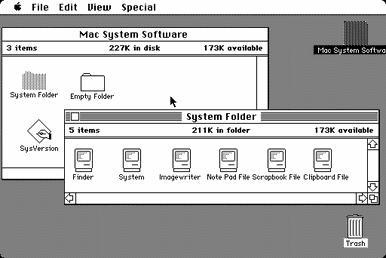 Once upon a time, there were three icons. A Poppa Application icon, a Momma Folder icon and a Baby Document icon. Life was good, and people were easily able to tell the difference between them, although very few visitors were known to go to that part of the forest.
Once upon a time, there were three icons. A Poppa Application icon, a Momma Folder icon and a Baby Document icon. Life was good, and people were easily able to tell the difference between them, although very few visitors were known to go to that part of the forest.But then along came the Trashcan icon... and the dark times began. If you dragged a folder to the trash it went away back into the void. But if you dragged a Special kind of folder called a Disk icon, it was EJECTED. The trash had discovered "Free will" and their eden was never the same again.
Suddenly, there were icons everywhere. Icons here, icons there. And all different kinds of icons, too. The icons not only overran the desktop, but they began to appear inside of applications. And they did so many different things! Where the poppa had once used WORDS to describe actions by way of MENUS, the icons stubbornly sat there silently.
So then along came Goldilocks. She had wandered onto the desktop innocently enough, but suddenly was propelled into an incomprehensible world of mysterious iconography... in other words, she couldn't make heads or tails of the icons by which she was surrounded. The only icon she thought she recognized was that pesky trashcan that had started all the trouble, and she figured she wanted to stay away from that one.
It was around this time that poor Goldilocks ran into the original Three Icons. "How could you have let this happen!" raged the girl. "It's not our fault, " moaned the icons. "We were never supposed to be a replacement for anything, we were just another way of looking at things!" they grumbled.
"100% data compression means 0% information," howled the Baby Document. "That was the beauty of it. Don't you get it, 0% information. The trashcan is behind all of this. It was the trashcan!"
Just then the trashcan showed up. "Hey kid, don't believe the hype. I deal with all of the things that no one wants, and look how they treat me."
Goldilocks was impressed by the smooth animation of the trashcan, as well as its nice 3-D appearance. "Well, I wouldn't quite put it that way," she said politely. The Trashcan didn't seem at all like she had expected.
"You wouldn't believe the things that people throw away. I'm talking some good stuff here!" said the Trashcan in a friendly tone. "Why just take a look at this..."
Goldilocks' curiosity was piqued. She leaned closer to take a look, and before the warning cries of the Three Icons could reach her, she was swallowed up, and then before you could say "Empty Trash" the poor thing was gone.
"How could you have deleted that poor innocent sweet girl!" sobbed the Momma Folder. "What girl?" burped the Trashcan.
Later, the Poppa Application was alone with the Momma Folder. "Don't worry, baby," he smiled. "I have a backup and restore function. If I can just figure out which icon it is..."
The End?



